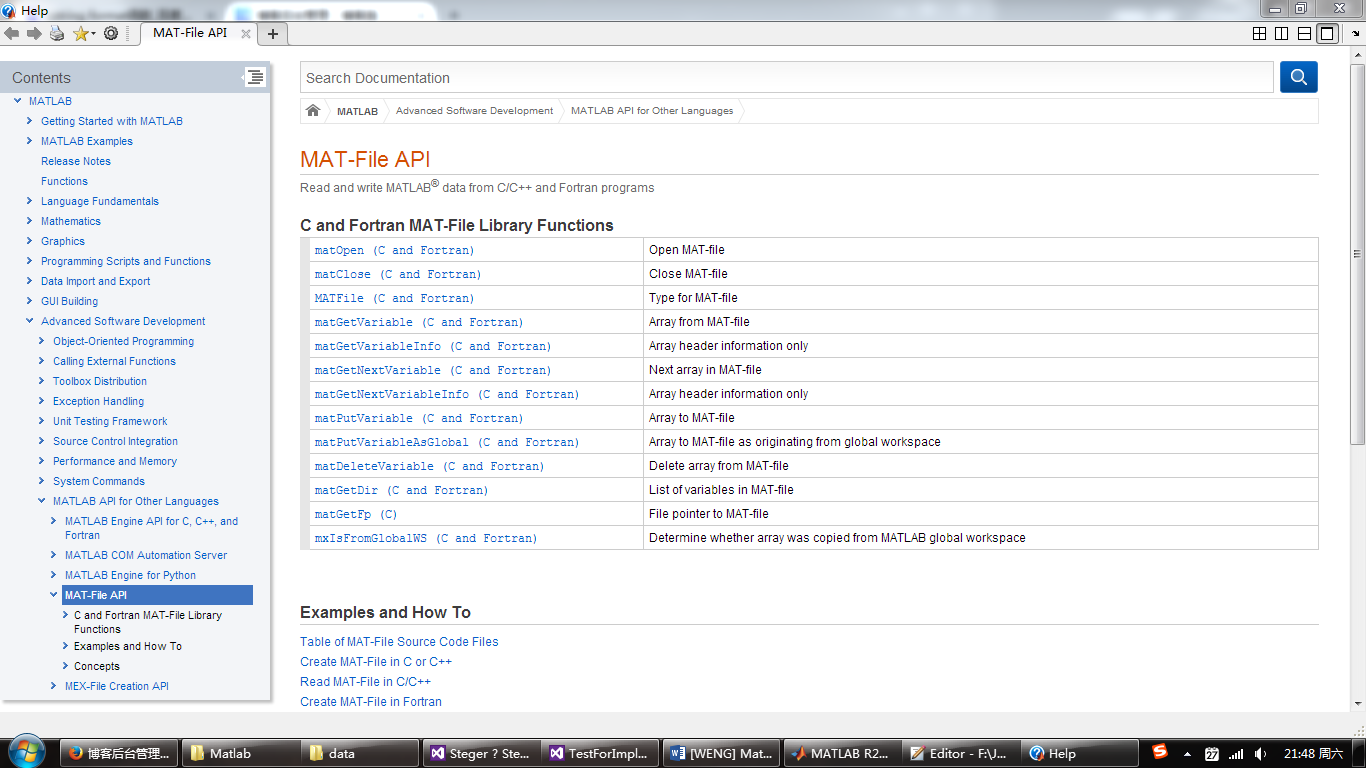年前,放假回家之前,使用了C++与matlab之间的数据的互动的一个实验,感觉效果挺好。初步达到了目的,所以整理下来方便大家使用。减少大家编程学习的时间。
希望对你们有用。
|
1
2
3
4
5
6
7
8
9
10
11
12
13
14
15
16
17
18
19
20
21
22
23
24
25
26
27
28
29
30
31
32
33
34
35
36
37
38
39
40
41
42
43
44
45
46
47
48
49
50
51
52
53
54
55
56
57
58
59
60
61
62
63
64
65
66
67
68
69
70
71
72
73
74
75
76
77
78
79
80
81
82
83
84
85
86
87
88
89
90
91
92
93
94
95
96
97
98
99
100
101
102
103
104
105
106
107
108
109
110
111
112
|
#include "mat.h"<br data-filtered="filtered"><br data-filtered="filtered">void example8(){ const char **fnames; /* pointers to field names */
const mwSize *dims;
mxArray *tmp, *fout;
char *pdata=NULL;
int i_field, nfields;
mxClassID *classIDflags;
mwIndex j_struct;
mwSize NumStructRecords;
mwSize ndim;
MATFile *pMF;
mxArray *pRoad, *pOut;
int status;
const char *file = "ContourRoadResults_AfterWidthEtcCorrect_4_ZY.mat";
printf("Opening file %s...\n\n", file);
pMF = matOpen(file, "u");
pRoad=matGetVariable(pMF, "ContourRoadResults");
/* get input arguments */
nfields = mxGetNumberOfFields(pRoad);
NumStructRecords = mxGetNumberOfElements(pRoad);
/* allocate memory for storing classIDflags */
classIDflags = (mxClassID*) mxCalloc(nfields, sizeof(mxClassID));
/* check empty field, proper data type, and data type consistency;
* and get classID for each field. */
for(i_field=0; i_field<nfields; i_field++)
{
for(j_struct = 0; j_struct < NumStructRecords; j_struct++)
{
tmp = mxGetFieldByNumber(pRoad, j_struct, i_field);
if(tmp == NULL)
{
printf("%s%d\t%s%d\n", "FIELD: ", i_field+1, "STRUCT INDEX :", j_struct+1);
//mexErrMsgIdAndTxt( "MATLAB:phonebook:fieldEmpty", "Above field is empty!");
}
if(j_struct==0)
{
if( (!mxIsChar(tmp) && !mxIsNumeric(tmp)) || mxIsSparse(tmp)) {
printf("%s%d\t%s%d\n", "FIELD: ", i_field+1, "STRUCT INDEX :", j_struct+1);
// mexErrMsgIdAndTxt( "MATLAB:phonebook:invalidField",
// "Above field must have either string or numeric non-sparse data.");
}
classIDflags[i_field]=mxGetClassID(tmp);
}
else
{
if (mxGetClassID(tmp) != classIDflags[i_field])
{
printf("%s%d\t%s%d\n", "FIELD: ", i_field+1, "STRUCT INDEX :", j_struct+1);
//mexErrMsgIdAndTxt( "MATLAB:phonebook:invalidFieldType",
// "Inconsistent data type in above field!");
} else if(!mxIsChar(tmp) &&
((mxIsComplex(tmp) || mxGetNumberOfElements(tmp)!=1))){
printf("%s%d\t%s%d\n", "FIELD: ", i_field+1, "STRUCT INDEX :", j_struct+1);
//mexErrMsgIdAndTxt( "MATLAB:phonebook:fieldNotRealScalar",
// "Numeric data in above field must be scalar and noncomplex!");
}
}
}
}
/* allocate memory for storing pointers */
fnames = (const char **)mxCalloc(nfields, sizeof(*fnames));
/* get field name pointers */
for (i_field=0; i_field< nfields; i_field++){
fnames[i_field] = (char*)mxGetFieldNameByNumber(pRoad,i_field);
}
/* create a 1x1 struct matrix for output */
pOut = mxCreateStructMatrix(1,1,nfields, fnames);
mxFree((void *)fnames);
ndim = mxGetNumberOfDimensions(pRoad);
dims = mxGetDimensions(pRoad);
for(i_field=0; i_field<nfields; i_field++) {
/* create cell/numeric array */
if(classIDflags[i_field] == mxCHAR_CLASS) {
fout = mxCreateCellArray(ndim, dims);
}else {
fout = mxCreateNumericArray(ndim, dims, classIDflags[i_field], mxREAL);
pdata = (char*)mxGetData(fout);
}
/* copy data from input structure array */
for (j_struct=0; j_struct<NumStructRecords; j_struct++) {
tmp = mxGetFieldByNumber(pRoad,j_struct,i_field);
if( mxIsChar(tmp)) {
mxSetCell(fout, j_struct, mxDuplicateArray(tmp));
}else {
mwSize sizebuf;
sizebuf = mxGetElementSize(tmp);
memcpy(pdata, mxGetData(tmp), sizebuf);
pdata += sizebuf;
}
}
/* set each field in output structure */
mxSetFieldByNumber(pOut, 0, i_field, fout);
}
matPutVariable(pMF, "OutputResult_Convert",pOut);
mxFree(classIDflags);
if (matClose(pMF) != 0) {
printf("Error closing file %s\n",file);
return;
}
printf("Done\n");
return;
} |
项目需要进行事先的C++ MEX混合编程的标准配置,再此不再赘述。要提醒的是,需要加入的头文件是#include "mat.h"。另外,具体的其他函数,请参照matlab的 MAT文件的读写的相关内容。

这个帮助对相关函数说明比较详细,参照相关的demo文件,你就能很快上手。
祝愿能解决你的问题!







 本文介绍了一个C++程序如何读取并处理Matlab的MAT文件中的数据结构,并将处理后的结果存回MAT文件的方法。该过程涉及到了C++中使用mat.h库对MAT文件的操作,包括获取字段名、数据类型一致性检查及数据复制等步骤。
本文介绍了一个C++程序如何读取并处理Matlab的MAT文件中的数据结构,并将处理后的结果存回MAT文件的方法。该过程涉及到了C++中使用mat.h库对MAT文件的操作,包括获取字段名、数据类型一致性检查及数据复制等步骤。
















 1万+
1万+

 被折叠的 条评论
为什么被折叠?
被折叠的 条评论
为什么被折叠?








